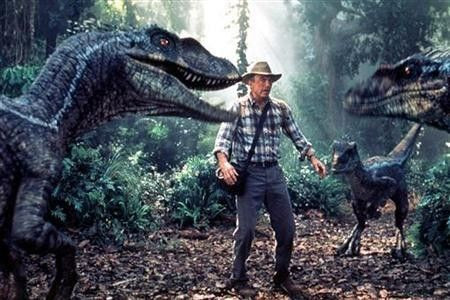'Jurassic Park' Got It Wrong On Velociraptors' Pack-Hunting Habits, Claims Study

KEY POINTS
- Movies often present velociraptors as intelligent pack hunters
- According to researchers, velociraptors likely did not hunt in packs
- Raptor teeth from the Cretaceous suggest adults did not feed their young
A new study found that contrary to the scenes presented in movies such as "Jurassic Park", raptors likely did not hunt in packs.
The image of raptors as intelligent, pack-hunting creatures is popular, partly because of the "Jurassic Park" movies where they are presented to engage in social hunting. However, vertebrate paleontologist Joseph Frederickson noted the evidence for this behavior is "not altogether convincing."
"The problem with this idea is that living dinosaurs (birds) and their relatives (crocodilians) do not usually hunt in groups and rarely ever hunt prey larger than themselves," Frederickson explained in a press release from the University of Wisconsin Oshkosh. "Further, behavior like pack hunting does not fossilize so we can't directly test whether the animals actually worked together to hunt prey."
An alternate hypothesis for raptors' hunting strategy is that they might have behaved more like modern-day predators such as crocodiles and Komodo dragons, in that individual creatures may attack the same prey, but not as a pack and with "limited" cooperation. This is certainly unlike the coordinated hunting scenes presented in movies.
"We proposed in this study that there is a correlation between pack hunting and the diet of animals as they grow," Frederiskcon said.
This is because there is a marked difference between the way social and asocial organisms rear their young. Social animals tend to feed their young while asocial animals do not.
For instance, young Komodo dragons have to scramble up the trees as soon as they hatch so that they will not get eaten by the adults. There, they have to take care of their own diet, which consists of a variety of prey that can fit in their mouths, from beetles to geckos and eggs. This makes their diet significantly different from diet of the ground-dwelling adults, something that would be evident in their teeth as they grow.
On the other hand, in social animals such as wolves, the adults provide food for their young, so a diet transition may not be evident in their teeth.
By comparing the teeth of old and juvenile raptors, researchers would have a better idea of whether they hunted in groups or not.
With this in mind, the researchers studied the teeth chemistry of Cretaceous crocodilians and raptors that lived in North America during the Cretaceous Period. They found differences in the smallest and largest teeth, indicating a shift in diet, thus suggesting asocial behavior.
"This is what we would expect for an animal where the parents do not provide food for their young," Frederickson said. "We also see the same pattern in the raptors, where the smallest teeth and the large teeth do not have the same average carbon isotope values, indicating they were eating different foods. This means the young were not being fed by the adults, which is why we believe Jurassic Park was wrong about raptor behavior."
Simply put, the evidence suggested the raptors were possibly asocial creatures and therefore would likely not hunt in packs like in the movies.
The study is published in the journal Palaeogeography, Palaeoclimatology, Palaeoecology.
© Copyright IBTimes 2024. All rights reserved.






















